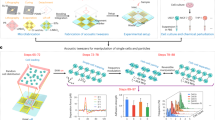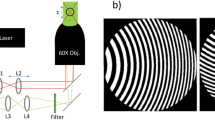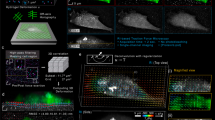Abstract
High-throughput ballistic injection nanorheology is a method for the quantitative study of cell mechanics. Cell mechanics are measured by ballistic injection of submicron particles into the cytoplasm of living cells and tracking the spontaneous displacement of the particles at high spatial resolution. The trajectories of the cytoplasm-embedded particles are transformed into mean-squared displacements, which are subsequently transformed into frequency-dependent viscoelastic moduli and time-dependent creep compliance of the cytoplasm. This method allows for the study of a wide range of cellular conditions, including cells inside a 3D matrix, cell subjected to shear flows and biochemical stimuli, and cells in a live animal. Ballistic injection lasts <1 min and is followed by overnight incubation. Multiple particle tracking for one cell lasts <1 min. Forty cells can be examined in <1 h.
This is a preview of subscription content, access via your institution
Access options
Subscribe to this journal
Receive 12 print issues and online access
$259.00 per year
only $21.58 per issue
Buy this article
- Purchase on Springer Link
- Instant access to full article PDF
Prices may be subject to local taxes which are calculated during checkout




Similar content being viewed by others
References
Hoh, J.H. & Schoenenberger, C.A. Surface morphology and mechanical properties of MDCK monolayers by atomic force microscopy. J. Cell. Sci. 107, 1105–1114 (1994).
Radmacher, M., Cleveland, J.P., Fritz, H.G., Hansma, H.G. & Hansma, P.K. Mapping interactions forces with the AFM. Biophys. J. 66, 2159–2165 (1994).
Domke, J., Parak, W.J., George, M., Gaub, H.E. & Radmacher, M. Mapping the mechanical pulse of single cardiomyocytes with the atomic force microscope. Eur. Biophys. J. 28, 179–186 (1999).
Radmacher, M. Studying the mechanics of cellular processes by atomic force microscopy. Methods Cell. Biol. 83, 347–372 (2007).
Hale, C.M., Sun, S.X. & Wirtz, D. Resolving the role of actoymyosin contractility in cell microrheology. PLoS ONE 4, e7054 (2009).
Daniels, B.R., Masi, B.C. & Wirtz, D. Probing single-cell micromechanics in vivo: the microrheology of C. elegans developing embryos. Biophys. J. 90, 4712–4719 (2006).
Lee, J.S. et al. Ballistic intracellular nanorheology reveals ROCK-hard cytoplasmic stiffening response to fluid flow. J. Cell. Sci. 119, 1760–1768 (2006).
Panorchan, P., Lee, J.S., Kole, T.P., Tseng, Y. & Wirtz, D. Microrheology and ROCK signaling of human endothelial cells embedded in a 3D matrix. Biophys. J. 91, 3499–3507 (2006).
Zhou, X. et al. Fibronectin fibrillogenesis regulates three-dimensional neovessel formation. Genes Dev. 22, 1231–1243 (2008).
Lekka, M. & Laidler, P. Applicability of AFM in cancer detection. Nat. Nanotechnol. 4, 72; author reply 72–73 (2009).
Mason, T.G., Ganesan, K., van Zanten, J.V., Wirtz, D. & Kuo, S.C. Particle-tracking microrheology of complex fluids. Phys. Rev. Lett. 79, 3282–3285 (1997).
Wirtz, D. Particle-tracking microrheology of living cells: principles and applications. Annu. Rev. Biophys. 38, 301–326 (2009).
Wu, J. & Dai, L.L. Apparent microrheology of oil-water interfaces by single-particle tracking. Langmuir 23, 4324–4331 (2007).
Wilson, L.G., Harrison, A.W., Schofield, A.B., Arlt, J. & Poon, W.C. Passive and active microrheology of hard-sphere colloids. J. Phys. Chem. B. 113, 3806–3812 (2009).
Vanapalli, S.A., Li, Y., Mugele, F. & Duits, M.H. On the origins of the universal dynamics of endogenous granules in mammalian cells. Mol. Cell. Biomech. 6, 191–201 (2009).
Sivaramakrishnan, S., DeGiulio, J.V., Lorand, L., Goldman, R.D. & Ridge, K.M. Micromechanical properties of keratin intermediate filament networks. Proc. Natl. Acad. Sci. USA 105, 889–894 (2008).
Silburn, S.A., Saunter, C.D., Girkin, J.M. & Love, G.D. Multidepth, multiparticle tracking for active microrheology using a smart camera. Rev. Sci. Instrum. 82, 033712 (2011).
Selvaggi, L. et al. Multiple-particle-tracking to investigate viscoelastic properties in living cells. Methods 51, 20–26 (2010).
Savin, T. & Doyle, P.S. Static and dynamic errors in particle tracking microrheology. Biophys. J. 88, 623–638 (2005).
Rogers, S.S., Waigh, T.A. & Lu, J.R. Intracellular microrheology of motile Amoeba proteus. Biophys. J. 94, 3313–3322 (2008).
Rogers, S.S., van der Walle, C. & Waigh, T.A. Microrheology of bacterial biofilms in vitro: Staphylococcus aureus and Pseudomonas aeruginosa. Langmuir 24, 13549–13555 (2008).
Rathgeber, S., Beauvisage, H.J., Chevreau, H., Willenbacher, N. & Oelschlaeger, C. Microrheology with fluorescence correlation spectroscopy. Langmuir 25, 6368–6376 (2009).
Papagiannopoulos, A., Waigh, T.A. & Hardingham, T.E. The viscoelasticity of self-assembled proteoglycan combs. Faraday Discuss. 139, 337–357; discussion 399–417, 419–420 (2008).
Papagiannopoulos, A., Fernyhough, C.M. & Waigh, T.A. The microrheology of polystyrene sulfonate combs in aqueous solution. J. Chem. Phys. 123, 214904 (2005).
Moschakis, T., Murray, B.S. & Dickinson, E. Particle tracking using confocal microscopy to probe the microrheology in a phase-separating emulsion containing nonadsorbing polysaccharide. Langmuir 22, 4710–4719 (2006).
Larsen, T.H. & Furst, E.M. Microrheology of the liquid-solid transition during gelation. Phys. Rev. Lett. 100, 146001 (2008).
Hasnain, I.A. & Donald, A.M. Microrheological characterization of anisotropic materials. Phys. Rev. E Stat. Nonlin. Soft Matter Phys. 73, 031901 (2006).
Haro-Perez, C., Garcia-Castillo, A. & Arauz-Lara, J.L. Confinement-induced fluid-gel transition in polymeric solutions. Langmuir 25, 8911–8914 (2009).
del Alamo, J.C., Norwich, G.N., Li, Y.S., Lasheras, J.C. & Chien, S. Anisotropic rheology and directional mechanotransduction in vascular endothelial cells. Proc. Natl. Acad. Sci. USA 105, 15411–15416 (2008).
Crocker, J.C. & Hoffman, B.D. Multiple-particle tracking and two-point microrheology in cells. Methods Cell. Biol. 83, 141–178 (2007).
Corrigan, A.M. & Donald, A.M. Particle tracking microrheology of gel-forming amyloid fibril networks. Eur. Phys. J. E Soft Matter 28, 457–462 (2009).
Corrigan, A.M. & Donald, A.M. Passive microrheology of solvent-induced fibrillar protein networks. Langmuir 25, 8599–8605 (2009).
Baker, E.L., Lu, J., Yu, D., Bonnecaze, R.T. & Zaman, M.H. Cancer cell stiffness: integrated roles of three-dimensional matrix stiffness and transforming potential. Biophys. J. 99, 2048–2057 (2010).
Baker, E.L., Bonnecaze, R.T. & Zaman, M.H. Extracellular matrix stiffness and architecture govern intracellular rheology in cancer. Biophys. J. 97, 1013–1021 (2009).
Alam, M.M. & Mezzenga, R. Particle tracking microrheology of lyotropic liquid crystals. Langmuir 27, 6171–6178 (2011).
Addas, K.M., Schmidt, C.F. & Tang, J.X. Microrheology of solutions of semiflexible biopolymer filaments using laser tweezers interferometry. Phys. Rev. E Stat. Nonlin. Soft Matter Phys. 70, 021503 (2004).
Tseng, Y., Kole, T.P. & Wirtz, D. Micromechanical mapping of live cells by multiple-particle-tracking microrheology. Biophys. J. 83, 3162–3176 (2002).
Kole, T.P., Tseng, Y. & Wirtz, D. Intracellular microrheology as a tool for the measurement of the local mechanical properties of live cells. Methods Cell. Biol. 78, 45–64 (2004).
Kole, T.P., Tseng, Y., Huang, L., Katz, J.L. & Wirtz, D. Rho kinase regulates the intracellular micromechanical response of adherent cells to rho activation. Mol. Biol. Cell. 15, 3475–3484 (2004).
Kole, T.P., Tseng, Y., Jiang, I., Katz, J.L. & Wirtz, D. Intracellular mechanics of migrating fibroblasts. Mol. Biol. Cell. 16, 328–338 (2005).
Gupton, S.L. et al. Cell migration without a lamellipodium: translation of actin dynamics into cell movement mediated by tropomyosin. J. Cell. Biol. 168, 619–631 (2005).
Xu, J., Viasnoff, V. & Wirtz, D. Compliance of actin filament networks measured by particle-tracking microrheology and diffusing wave spectroscopy. Rheologica. Acta 37, 387–398 (1998).
Tseng, Y. et al. How actin crosslinking and bundling proteins cooperate to generate an enhanced cell mechanical response. Biochem. Biophys. Res. Commun. 334, 183–192 (2005).
Panorchan, P. et al. Probing cellular mechanical responses to stimuli using ballistic intracellular nanorheology. Methods Cell. Biol. 83, 115–140 (2007).
Lee, J.S. et al. Nuclear lamin A/C deficiency induces defects in cell mechanics, polarization, and migration. Biophys. J. 93, 2542–2552 (2007).
Rufener, K., Palmer, A., Xu, J. & Wirtz, D. High-frequency dynamics and microrheology of macromolecular solutions measured by diffusing wave spectroscopy: the case of actin filament networks. J. NonNewtonian Fluid. Mech. 82, 303–314 (1999).
Mason, T.G., Dhople, A. & Wirtz, D. in Statistical Mechanics in Physics and Biology (eds. Wirtz, D. & Halsey, T.C.) 153–158 (Materials Research Society, 1997).
Mizuno, D., Tardin, C., Schmidt, C.F. & Mackintosh, F.C. Nonequilibrium mechanics of active cytoskeletal networks. Science 315, 370–373 (2007).
Lau, A.W., Hoffman, B.D., Davies, A., Crocker, J.C. & Lubensky, T.C. Microrheology, stress fluctuations, and active behavior of living cells. Phys. Rev. Lett. 91, 198101 (2003).
Hoffman, B.D., Massiera, G., Van Citters, K.M. & Crocker, J.C. The consensus mechanics of cultured mammalian cells. Proc. Natl. Acad. Sci. USA 103, 10259–10264 (2006).
Yamada, S., Wirtz, D. & Kuo, S.C. Mechanics of living cells measured by laser tracking microrheology. Biophys. J. 78, 1736–1747 (2000).
Spence, P., Gupta, V., Stephens, D.J. & Hudson, A.J. Optimising the precision for localising fluorescent proteins in living cells by 2D Gaussian fitting of digital images: application to COPII-coated endoplasmic reticulum exit sites. Eur. Biophys. J. 37, 1335–1349 (2008).
Crocker, J.C. & Grier, D.G. Methods of digital video microscopy for colloidal studies. J. Colloid Interface Sci. 179, 298–310 (1996).
Gonzalez, R.C. & Woods, R.E. Digital Image Processing (Prentice Hall, 2002).
Wu, P.H., Nelson, N. & Tseng, Y. A general method for improving spatial resolution by optimization of electron multiplication in CCD imaging. Opt. Express 18, 5199–5212 (2010).
Wu, P.H., Arce, S.H., Burney, P.R. & Tseng, Y. A novel approach to high accuracy of video-based microrheology. Biophys. J. 96, 5103–5111 (2009).
Savitzky, A. & Golay, M.J.E. Smoothing and differentiation of data by simplified least squares procedures. Anal. Chem. 36, 1627–1639 (1964).
Qian, H., Sheetz, M.P. & Elson, E.L. Single particle tracking. Analysis of diffusion and flow in two-dimensional systems. Biophys. J. 60, 910–921 (1991).
Mason, T.G. Estimating the viscoelastic moduli of complex fluids using the generalized Stokes-Einstein equation. Rheologica. Acta 39, 371–378 (2000).
Dasgupta, B.R., Tee, S.-Y., Crocker, J.C., Friseken, B.J. & Weitz, D.A. Microrheology of polyethylene oxide using diffusing wave spectroscopy and single scattering. Phys. Rev. E 65, 051505 (2002).
Palmer, A., Xu, J. & Wirtz, D. High-frequency rheology of crosslinked actin networks measured by diffusing wave spectroscopy. Rheologica. Acta 37, 97–108 (1998).
Palmer, A., Xu, J., Kuo, S.C. & Wirtz, D. Diffusing wave spectroscopy microrheology of actin filament networks. Biophys. J. 76, 1063–1071 (1999).
Daniels, B.R. et al. Differences in the microrheology of human embryonic stem cells and human induced pluripotent stem cells. Biophys. J. 99, 3563–3570 (2010).
Hale, C.M. et al. Dysfunctional connections between the nucleus and the actin and microtubule networks in laminopathic models. Biophys. J. 95, 5462–5475 (2008).
Stewart-Hutchinson, P.J., Hale, C.M., Wirtz, D. & Hodzic, D. Structural requirements for the assembly of LINC complexes and their function in cellular mechanical stiffness. Exp. Cell. Res. 314, 1892–1905 (2008).
Tseng, Y., Lee, J.S., Kole, T.P., Jiang, I. & Wirtz, D. Micro-organization and visco-elasticity of the interphase nucleus revealed by particle nanotracking. J. Cell. Sci. 117, 2159–2167 (2004).
Baker, E.L., Lu, J., Yu, D., Bonnecaze, R.T. & Zaman, M.H. Cancer cell stiffness: integrated roles of three-dimensional matrix stiffness and transforming potential. Biophys. J. 99, 2048–2057 (2010).
Rahman, A., Tseng, Y. & Wirtz, D. Micromechanical coupling between cell surface receptors and RGD peptides. Biochem. Biophys. Res. Commun. 296, 771–778 (2002).
Fire, A. Integrative transformation of Caenorhabditis elegans. EMBO J. 5, 2673–2680 (1986).
Panorchan, P., Tseng, Y. & Wirtz, D. Structure-function relationship of biological gels revealed by multiple particle tracking and differential interference contrast microscopy: The case of human lamin networks. Phys. Rev. E 70, 041906 (2004).
Fraley, S.I. et al. A distinctive role for focal adhesion proteins in three-dimensional cell motility. Nat. Cell Biol. 12, 598–604 (2010).
Fraley, S.I., Feng, Y., Wirtz, D. & Longmore, G.D. Reply: reducing background fluorescence reveals adhesions in 3D matrices. Nat. Cell Biol. 13, 5–7 (2011).
Acknowledgements
Normal human ovarian epithelial cells (OSE10) and ovarian cancer cells (OVCAR3) were provided by I.-M. Shih (Department of Pathology, Johns Hopkins University School of Medicine). This work was supported in part by NIH grants U54CA143868 and R21CA137686, and RO1GM084204. We thank members of the Wirtz and Tseng labs for technical advice and reagents.
Author information
Authors and Affiliations
Contributions
P.-H.W., C.M.H. and W.-C.C. conducted experiments. P.-H.W., C.M.H., J.S.H.L., Y.T. and D.W. designed the experiments, analyzed the results and wrote the paper.
Corresponding authors
Ethics declarations
Competing interests
The authors declare no competing financial interests.
Rights and permissions
About this article
Cite this article
Wu, PH., Hale, C., Chen, WC. et al. High-throughput ballistic injection nanorheology to measure cell mechanics. Nat Protoc 7, 155–170 (2012). https://doi.org/10.1038/nprot.2011.436
Published:
Issue Date:
DOI: https://doi.org/10.1038/nprot.2011.436
This article is cited by
-
E-cadherin interacts with EGFR resulting in hyper-activation of ERK in multiple models of breast cancer
Oncogene (2024)
-
Correlative light-electron microscopy using small gold nanoparticles as single probes
Light: Science & Applications (2023)
-
Single probes and resonant four-wave-mixing enabling novel correlative light electron microscopy workflow
Light: Science & Applications (2023)
-
A comparison of methods to assess cell mechanical properties
Nature Methods (2018)
-
Biophysical and biomolecular determination of cellular age in humans
Nature Biomedical Engineering (2017)
Comments
By submitting a comment you agree to abide by our Terms and Community Guidelines. If you find something abusive or that does not comply with our terms or guidelines please flag it as inappropriate.



